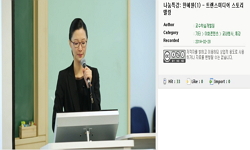Background With the emergence of constantly changing media and the importance placed on interconnectivity from the context of new social cultural paradigms, it is now critical to understand, anticipate and manage the phenomena of change. This study ex...
http://chineseinput.net/에서 pinyin(병음)방식으로 중국어를 변환할 수 있습니다.
변환된 중국어를 복사하여 사용하시면 됩니다.
- 中文 을 입력하시려면 zhongwen을 입력하시고 space를누르시면됩니다.
- 北京 을 입력하시려면 beijing을 입력하시고 space를 누르시면 됩니다.
https://www.riss.kr/link?id=A99716717
- 저자
- 발행기관
- 학술지명
- 권호사항
-
발행연도
2013
-
작성언어
Korean
-
주제어
Transing ; Transmarketing ; Transmedia ; Transbranding ; 트랜징 ; 트랜스마케팅 ; 트랜스미디어 ; 트랜스브랜딩
-
KDC
658
-
등재정보
KCI등재,SCOPUS
-
자료형태
학술저널
- 발행기관 URL
-
수록면
435-463(29쪽)
- 제공처
- 소장기관
-
0
상세조회 -
0
다운로드
부가정보
다국어 초록 (Multilingual Abstract)
Methods An empirical study was conducted to analyze relevant case studies in order to project the appropriate conceptual and strategic implications for transbranding. In order to develop a systematic framework for transbranding, theoretical research related to transing, transmarketing and transmedia was initiated to establish an operational structure for corporate brand management. Some of the key studies that were referenced to formulate a road map for transbranding included Slywotzky & Morrison(2000)’s Digital Business Design(DDB) matrix which formed the basis to create key components and future usability of transmedia. In addition, using the 2012 brand valuation ranking by Interbrand, the study chose top ranked global companies such as Coca-Cola, Google and IKEA for an empirical case analysis of their current transbranding capabilities. An analytical tool Transmedia Mix was used to measure four attributes: Evolution
Interaction(EI), Collaborative Creation(CC), Systematic Multi-experience(SM), Sustainable Identity(SI) to evaluate the relevant brand design criteria for assessing the Style Management(SM) components in establishing a 2F(Flexible Fit) strategy.
Results As for the key findings of the empirical research using the transmedia mix model, Coca-Cola, Google and Ikea were all found to have maintained unique brand values that reflected both the dynamic and participatory characteristics of transbranding. Although there were some slight differences in the effectiveness between the three companies upon analyzing the transbranding strategic criteria, there were overall high marks for both transmedia and brand design and clear indications that efficient usage projected a distinctive brand image. In addition, it was found that effective transbranding could be achieved when companies successfully adapt a balanced combination of the four components of transmedia mix strategy to effectively produce an extended 2F(Flexible Fit) system that can enable a coherent brand experience to enhance the key values of the companies.
Conclusion In closing, it is predicted that the future role of transbranding will become more relevant as media continues to expand and evolve. As a new approach to branding will be necessitated to encompass the extended variables that include media, business, and design technology, a transdisciplinary method can become a viable alternative solution. Thus, the proper style management implementation for transmedia strategies can better communicate the experiential aspirations of the modern consumer. Furthermore, successful transbranding can be better realized with an effective brand system implementation of the 2F strategy that is integrated with the evolving technological elements of changing design media.
Background With the emergence of constantly changing media and the importance placed on interconnectivity from the context of new social cultural paradigms, it is now critical to understand, anticipate and manage the phenomena of change. This study examines the phenomena of change in the expansion and evolution of the media environment through the new concept of “transing” and proposes “transbranding” as an effective strategic method for future corporate brand management. This paper further suggests that transbranding can become the new standard for Branding 2.0 to enable corporations and brands to overcome the chaos and uncertainty that is representative of the current marketing environment to achieve a more dynamic style brand management.
Methods An empirical study was conducted to analyze relevant case studies in order to project the appropriate conceptual and strategic implications for transbranding. In order to develop a systematic framework for transbranding, theoretical research related to transing, transmarketing and transmedia was initiated to establish an operational structure for corporate brand management. Some of the key studies that were referenced to formulate a road map for transbranding included Slywotzky & Morrison(2000)’s Digital Business Design(DDB) matrix which formed the basis to create key components and future usability of transmedia. In addition, using the 2012 brand valuation ranking by Interbrand, the study chose top ranked global companies such as Coca-Cola, Google and IKEA for an empirical case analysis of their current transbranding capabilities. An analytical tool Transmedia Mix was used to measure four attributes: Evolution
Interaction(EI), Collaborative Creation(CC), Systematic Multi-experience(SM), Sustainable Identity(SI) to evaluate the relevant brand design criteria for assessing the Style Management(SM) components in establishing a 2F(Flexible Fit) strategy.
Results As for the key findings of the empirical research using the transmedia mix model, Coca-Cola, Google and Ikea were all found to have maintained unique brand values that reflected both the dynamic and participatory characteristics of transbranding. Although there were some slight differences in the effectiveness between the three companies upon analyzing the transbranding strategic criteria, there were overall high marks for both transmedia and brand design and clear indications that efficient usage projected a distinctive brand image. In addition, it was found that effective transbranding could be achieved when companies successfully adapt a balanced combination of the four components of transmedia mix strategy to effectively produce an extended 2F(Flexible Fit) system that can enable a coherent brand experience to enhance the key values of the companies.
Conclusion In closing, it is predicted that the future role of transbranding will become more relevant as media continues to expand and evolve. As a new approach to branding will be necessitated to encompass the extended variables that include media, business, and design technology, a transdisciplinary method can become a viable alternative solution. Thus, the proper style management implementation for transmedia strategies can better communicate the experiential aspirations of the modern consumer. Furthermore, successful transbranding can be better realized with an effective brand system implementation of the 2F strategy that is integrated with the evolving technological elements of changing design media.
동일학술지(권/호) 다른 논문
-
Finding Serendipity in Early Prototyping
- 한국디자인학회
- Lucas Lacerda
- 2013
- KCI등재,SCOPUS
-
DEVELOPMENT OF A RETAIL BRAND ENHANCEMENT TOOL THROUGH THE USE OF EMOTIONAL DESIGN THEORY
- 한국디자인학회
- Junkyu Hwang
- 2013
- KCI등재,SCOPUS
-
Understanding of Healthcare Design
- 한국디자인학회
- Mei-PingFu
- 2013
- KCI등재,SCOPUS
-
Crowdsourcing Designers' Insights Into Collaboration
- 한국디자인학회
- Søren Ingomar Petersen
- 2013
- KCI등재,SCOPUS






 DBpia
DBpia






